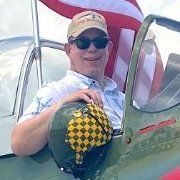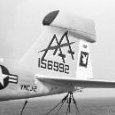-
Posts
147 -
Joined
-
Last visited
-
Days Won
1
Hoss FL last won the day on September 11 2022
Hoss FL had the most liked content!
About Hoss FL
- Birthday 11/19/1963
Profile Information
-
Location
St. Augustine, FL
-
Interests
Model aircraft, history, photography, sports
Recent Profile Visitors
1,886 profile views
-
 Castor reacted to a post in a topic:
1/32 Tamiya P-51D - The Millie G
Castor reacted to a post in a topic:
1/32 Tamiya P-51D - The Millie G
-
 Castor reacted to a post in a topic:
1/32 Hasegawa Fw 190D-9 - Hans Dortenmann's Black 1
Castor reacted to a post in a topic:
1/32 Hasegawa Fw 190D-9 - Hans Dortenmann's Black 1
-
 Archimedes reacted to a post in a topic:
*** 1/32 Kotare Spitfire Mk.Ia "Brian Lane" COMPLETE ***
Archimedes reacted to a post in a topic:
*** 1/32 Kotare Spitfire Mk.Ia "Brian Lane" COMPLETE ***
-
 SwissFighters reacted to a post in a topic:
1/32 Tamiya P-51D - The Millie G
SwissFighters reacted to a post in a topic:
1/32 Tamiya P-51D - The Millie G
-
 Hoss FL reacted to a post in a topic:
*** Finished*** 1/32 Hasegawa P-47D-30 "Duck Butt"
Hoss FL reacted to a post in a topic:
*** Finished*** 1/32 Hasegawa P-47D-30 "Duck Butt"
-
 Mekon reacted to a post in a topic:
*** 1/32 Kotare Spitfire Mk.Ia "Brian Lane" COMPLETE ***
Mekon reacted to a post in a topic:
*** 1/32 Kotare Spitfire Mk.Ia "Brian Lane" COMPLETE ***
-
 MikeMaben reacted to a post in a topic:
Thunderbolt ... edited pix
MikeMaben reacted to a post in a topic:
Thunderbolt ... edited pix
-
 Biggles87 reacted to a post in a topic:
1/32 Kotare Spitfire Mk.Ia "Brian Lane"
Biggles87 reacted to a post in a topic:
1/32 Kotare Spitfire Mk.Ia "Brian Lane"
-
 Fanes reacted to a post in a topic:
1/32 Kotare Spitfire Mk.Ia "Brian Lane"
Fanes reacted to a post in a topic:
1/32 Kotare Spitfire Mk.Ia "Brian Lane"
-
 Hoss FL reacted to a post in a topic:
Revell P-51D-15 (Late) **Completed**
Hoss FL reacted to a post in a topic:
Revell P-51D-15 (Late) **Completed**
-
 Martinnfb reacted to a post in a topic:
1/32 Kotare Spitfire Mk.Ia "Brian Lane"
Martinnfb reacted to a post in a topic:
1/32 Kotare Spitfire Mk.Ia "Brian Lane"
-
 Martinnfb reacted to a post in a topic:
1/32 Kotare Spitfire Mk.Ia "Brian Lane"
Martinnfb reacted to a post in a topic:
1/32 Kotare Spitfire Mk.Ia "Brian Lane"
-
Speeding along. Looking great, Mike.
-
Thanks all for the nice comments. Much appreciated. By the way, I was pleased to learn that Kotare used some of my photos on their website and marketing content. That's a first for me. https://www.kotare-models.com/products/k32601-kotare-132-spitfire-mkia-brian-lane https://www.facebook.com/kotaremodels/
- 23 replies
-
 Hoss FL reacted to a post in a topic:
1/32 Kotare Spitfire Mk.Ia "Brian Lane"
Hoss FL reacted to a post in a topic:
1/32 Kotare Spitfire Mk.Ia "Brian Lane"
-
 Hoss FL reacted to a post in a topic:
1/32 Kotare Spitfire Mk.Ia "Brian Lane"
Hoss FL reacted to a post in a topic:
1/32 Kotare Spitfire Mk.Ia "Brian Lane"
-
 Hoss FL reacted to a post in a topic:
1/32 Kotare Spitfire Mk.Ia "Brian Lane"
Hoss FL reacted to a post in a topic:
1/32 Kotare Spitfire Mk.Ia "Brian Lane"
-
 Hoss FL reacted to a post in a topic:
1/32 Kotare Spitfire Mk.Ia "Brian Lane"
Hoss FL reacted to a post in a topic:
1/32 Kotare Spitfire Mk.Ia "Brian Lane"
-
 Hoss FL reacted to a post in a topic:
1/32 Kotare Spitfire Mk.Ia "Brian Lane"
Hoss FL reacted to a post in a topic:
1/32 Kotare Spitfire Mk.Ia "Brian Lane"
-
 Hoss FL reacted to a post in a topic:
1/32 Kotare Spitfire Mk.Ia "Brian Lane"
Hoss FL reacted to a post in a topic:
1/32 Kotare Spitfire Mk.Ia "Brian Lane"
-
 Hoss FL reacted to a post in a topic:
1/32 Kotare Spitfire Mk.Ia "Brian Lane"
Hoss FL reacted to a post in a topic:
1/32 Kotare Spitfire Mk.Ia "Brian Lane"
-
 Hoss FL reacted to a post in a topic:
1/32 Kotare Spitfire Mk.Ia "Brian Lane"
Hoss FL reacted to a post in a topic:
1/32 Kotare Spitfire Mk.Ia "Brian Lane"
-

*** 1/32 Kotare Spitfire Mk.Ia "Brian Lane" COMPLETE ***
Hoss FL replied to Hoss FL's topic in Works in Progress
Thanks all for the warm comments. I was pleased to learn that Kotare used some of my photos for their website and marketing. Here's a link. By the way, I highly recommend the kit. https://www.kotare-models.com/products/k32601-kotare-132-spitfire-mkia-brian-lane https://www.facebook.com/kotaremodels/- 87 replies
-
- wwii
- brian lane
-
(and 4 more)
Tagged with:
-
NICE! What a beast. Love the kit and your work is superb. Congrats!
-
Greetings fellow modelers: This was one of the most enjoyable projects I've done. The Kotare Spitfire Mk.Ia "Brian Lane" kit is fantastic. The Kotare team certainly put a lot of effort into creating a wonderful build experience for the modeler. And they pulled it off. In this brief, ready-for-inspection summary I'll share my build overview, my thoughts on the kit and some recommendations for future kit builders as I go through the photos. Here's a link to the build: Ok, here's my rendition of QV-K P9386 from September 1940. The quality of the molding, engineering, decals, and thoroughness and thoughtfulness of the 24-page instruction book really made this project a pleasure. I built the kit completely out of the box with the exception of Eduard masks for the canopy. Kotare's design philosophy made for a superb assembly process. Each main engine panel was molded as an individual part -- no seam lines or glue clean up. The fuselage aft section parts all intersect at panel line joins. The wing fairings are each single molded parts that fit perfectly. It's designed so that one can assemble the entire plane almost without a single seam line that intersects a rivet line or panel line. What a pleasure. The only area where this occurs is underneath the aft section of the fuselage -- conveniently away from normal viewing. I can't think of a single situation where the fit was not PERFECT. For example, there is only one way to install the landing gear struts. Full stop. There's no play, no wiggle, no uncertainty. One of the best designs I've seen. The horizontal stabilizers are one piece and there's only one way to install it for a nice, tight fit in perfect alignment. The prop assembly installs by literally fitting a square peg in a round hole for a perfect fit. Another nice treat is that the rudder and elevators are positioned off-center and match the positions of the control stick and rudder pedals in the cockpit. I haven't seen that before. That's just one of the many nice details and surprises discovered as one works through the build. Even the trim tabs are offset slightly. As for painting, the instructions provide extremely helpful guides for painting the cockpit as well as the exterior. For the cockpit, painting call outs are provided during the build steps and there are also summary diagrams with multiple views in full color. For the exterior, four full color views are provided for the aircraft with color call outs and key points. I used Mr. Color lacquers for the main camo colors (C361 for Dark Green and C369 for Dark Earth) and MRP Marking Yellow for the spinner. I mixed by own version of Sky Blue for the underside using Mr Color White, RLM 76 and Sky Blue. Since I wanted to emphasize color variation across the different subassemblies as the instructions pointed out, I painted some of the panels a little darker or lighter or a slightly different shade of green or brown. For example the fabric covered sections are a little more faded than the metal sections. I used the kit decals by Cartograf, which were fabulous -- perfect color, perfect register, nice and thin, no excess carrier film. All good. The main challenge with the decals was getting them to settle over the raised rivet areas on the aft part of the fuselage. It took several days of bubble popping and decal solution application to get them to finally behave around the rivets but they got there. I planned out the weathering process at the start of the project. My goal was to reflect what I saw in the reference photos -- and there are multiple clear photos of P9386 as well as several other Spitfires that are very helpful. One of the photos of a real spitfire elevator section has a humorous caption highlighting that there's no evidence of preshading on the fabric area. After priming with Mr Finishing Surfacer 1500, I painted the wing roots MC201 Super Fine Silver, then applied AK worn effects fluid over the silver areas. I pre-shaded the panel lines in black and then applied heavy marbling using spatter templates and random airbrush patterns to break up the solid panel colors. After the main camo painting, I dabbed the wing root areas with a wet brush to get the chipping effect I was after. Next was a gloss coat to seal in the chipping and prep for decals. After the decals and flat coat, I augmented the chipped wing roots with a sharp silver Prismacolor pencil to add some scratches and make some of the chipped areas "less round" and more random looking. The exhausts each are molded in top and bottom halves. There's a nice close up photo in the instructions showing the weld seams that can be replicated when you glue the exhausts together and let some glue squeeze out of the seams. I needed to add a little material to the tips of the exhausts to get the proper shape and I used my motor tool to drill out the exhaust interiors. I used reference photos for guidance on painting the exhausts. I started with gloss black and then applied a 1:1 mix of Mr Color Metallic Black and Super Stainless. After the decals were applied on the lower side of the manifolds, I used Tamiya acrylics to achieve the exhaust gas/heat color pattern. Black, purple, brown, orange, and deck tan were used. The cockpit detail that comes with the kit is astounding in my view. The instrument panel dials all have individual decals and there are placards all over the place - sidewalls, compass, gunsight, etc. Also, in the photo above, the molded seatbelt harness is visible, which I think looks pretty good. The figure of Brian Lane was a nice bonus and here's my attempt at painting him. There's a nice painting guide in the instructions. Overall Summary of the kit: Highlights Clear, detailed, comprehensive instructions. I may keep the book as a reference for other builds. Excellent. Design and fit for easy assembly and minimal clean up. Decals by Cartograf - cockpit decals and placards as well as the main markings and stencils Brian Lane figure - Colorful RAF pilot uniforms are great subjects. Aircraft interior and exterior color profiles in the instructions Surface detail - stressed skin effect around some fasteners, rivets, panel fasteners, hinges -- all good. Fine and consistent panel lines Landing gear design - "weighted" wheels with flat spots and slight bulges. Things to look out for (for future builders) My copy had some very slight molding sink marks on the tops of the wings above the wheel wells. Easy clean up. The exhaust manifold tips needed some extra filler material (CA glue). Again, easy clean up. The molded seatbelt harness is fairly thick in the section between the seat top and the armor plate slot. I thinned the seatbelt quite a bit by scraping underneath and cleaning up. Another option is an aftermarket seatbelt as the kit provides a seat without the molded seatbelt. Some of the molded detail needed a little sprucing up. Nothing major. Thanks for looking. Needless to say, I highly recommend this kit. Comments and critiques are more than welcome. - Jim Jenson
- 23 replies
-

*** 1/32 Kotare Spitfire Mk.Ia "Brian Lane" COMPLETE ***
Hoss FL replied to Hoss FL's topic in Works in Progress
My rendition of Spitfire QV-K is now complete. Since the last update, I applied another gloss coat over the decals, applied an oil panel line wash, did some weathering to match the photos as best as possible and finalized assembly. Here are a few teaser photos. Here's the link the to RFI page: Thanks again for the comments and for following along.- 87 replies
-
- wwii
- brian lane
-
(and 4 more)
Tagged with:
-
Moving fast on this one. Looks great so far!
-

*** Finished*** 1/32 Dragon Bf-109E-3 "Dr Erich Mix"
Hoss FL replied to Tolga ULGUR's topic in Works in Progress
Cool camo scheme. Following along. -

*** 1/32 Kotare Spitfire Mk.Ia "Brian Lane" COMPLETE ***
Hoss FL replied to Hoss FL's topic in Works in Progress
Time for another update. The decals are now complete. The decals are by Cartograf and they are thin, in perfect register, the colors look spot on and they conformed to the surface as well as any I've used. The model really comes to life when the markings go on. The stencils were apparently overpainted on the underside when the aircraft was painted from the black and white scheme to Sky Blue. Note to future bulders of this kit. The decal process over the extensive positive rivets took a long time, tested my patience, but worked in the end. If you zoom in you can see the zillions of rivets that each decided to become a bubble during the decal process. The exhausts are cool and the kit has decals for the manifolds. My version of inconel is gloss black base coat followed by a 1:1 mix of Mr Color Metallic Black and Super Stainless. I'll weather the exhausts after sealing in the decals. Here's my work on the figure so far. Still a long way to go. Next is a gloss coat over the decals and then a panel line wash. Thanks for looking. Comments and critiques always welcome.- 87 replies
-
- wwii
- brian lane
-
(and 4 more)
Tagged with:
-

*** Finished*** 1/32 Hasegawa & Montex -Focke Wulf Fw-190A3
Hoss FL replied to Tolga ULGUR's topic in Works in Progress
Bravo, Tolga! That Würger looks fantastic. One of my favorites. The paintwork and finish are superb. Well done! Congrats. -

*** 1/32 Kotare Spitfire Mk.Ia "Brian Lane" COMPLETE ***
Hoss FL replied to Hoss FL's topic in Works in Progress
Time for a quick update. The main topside camo is now complete. I started with the Dark Earth using Mr Color C369. I've had good results using white tack for the masking boundaries - no ridge and a relatively hard edge line. The base dark green was Mr Color C361, but I used a number of other similar colors to depict the variety of paint from the various subcontractors (engine panels, tail section, canopy frame, etc.) and the lightening of the fabric surfaces. The variation is subtle but it's there. It may go unnoticed after decals, panel line washes and other weathering, but it will contribute to the overall look I'm shooting for. That's all for now. Gloss coat and decals next. Thanks again for looking. Comments and critiques always welcome.- 87 replies
-
- wwii
- brian lane
-
(and 4 more)
Tagged with:
-

*** 1/32 Kotare Spitfire Mk.Ia "Brian Lane" COMPLETE ***
Hoss FL replied to Hoss FL's topic in Works in Progress
Got some more work done on the first day of 2024. Primed with Mr Finishing Surfacer. I needed to clean up a few areas but nothing out of the ordinary. Then I applied some MC201 Super Fine Silver onto the wing roots, followed by a coat of AK Wear Effects Fluid. Next was some panel line preshading using a thin mix of black. I used some spatter templates to create some variation across the panels. Finally, I applied Sky Blue, created using a mix of AK and Mr. Color whites and light blues to match my reference, to the underside. I applied 5 or 6 thin layers of varying highlights and base color and left some subtle preshading showing through. The Kotare instructions say that the underside can be Sky or Sky Blue and the color profile itself looks like Sky Blue, so that was my choice. Thanks again for looking. Comments and critiques always welcome.- 87 replies
-
- wwii
- brian lane
-
(and 4 more)
Tagged with:
-
Nice work Sepp! Great way to wrap up 2023. Congrats.
-
Just joining late -- stunning work so far. I love this kit and your diorama is going to be stellar.



